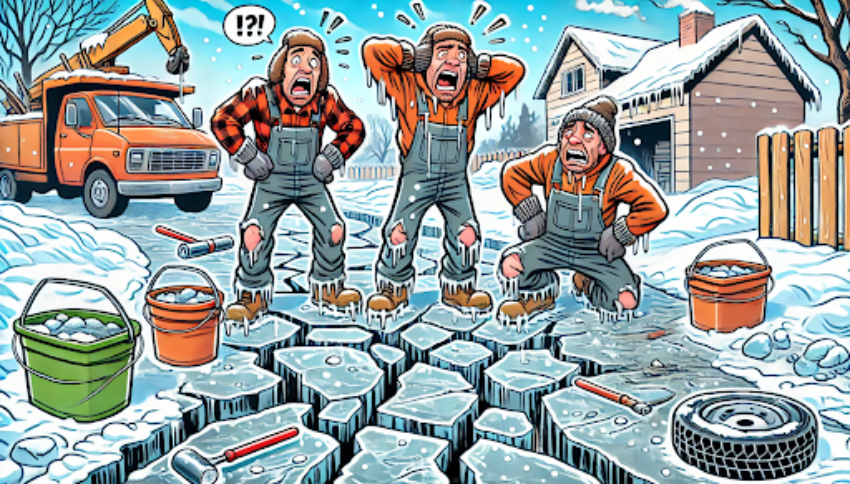Can Mudjacking Be Done in the Winter? Why We Don't Recommend It
Mudjacking is a highly effective method for lifting and leveling unevenly settled concrete slabs. This process involves using special equipment to lift the slab(s) and then injecting a mixture of sand, water, soil, and cement—referred to as slurry—beneath the slab to raise and level it into place. This blog will address your question, “Can mudjacking be done in the winter?” plus give yousome expert tips on how to avoid problems so you can get the best results possible.
Don’t Let Winter Stop You from Fixing Your Concrete Issues! Act Now and Ensure Your Property’s Stability No Matter the Season.
Call (347) 284-0280 Now!
Reasons Why Mudjacking Should Not Be Done in the Winter
In winter, the ground is frozen, which presents significant challenges for mudjacking. When the water in the ground freezes, it expands, causing the ground beneath the slab to move. This can lead to the slab shifting or breaking, making the mudjacking process ineffective.
Furthermore, with the spring thaw, any mudjacking work done during the winter can further shift the concrete. This compounds existing issues and can present new problems, requiring additional repairs. Ethically, it is not in the best interest of our clients to perform mudjacking during the winter months due to these risks.
The Best Time for Mudjacking
The best time for mudjacking, also known as slabjacking or mudjacking concrete leveling, is typically during the warmer months, from late spring to early fall. This period offers optimal conditions for the materials used in the process to cure properly. Cold weather can cause the materials to freeze before they set, leading to ineffective repairs, while excessive heat can cause them to dry too quickly. Additionally, the ground is more stable during these months, reducing the risk of further shifting or settling. By scheduling mudjacking during this ideal window, you can ensure a more durable and long-lasting repair for your concrete surfaces.
Here’s some more reasons why cool weather is recommended for this process:
Why Choose Cool Weather (spring/fall)?
Cool-weather, particularly in the spring and fall, provides optimal conditions for mudjacking. During these seasons, the joints in the concrete are more open, allowing the grout mixture to penetrate and fill voids more effectively.
Here are a few reasons why cool weather is ideal:
- Open Joints: In cooler temperatures, concrete contracts, causing the joints to open. This makes it easier for the grout mixture to flow and fill the voids beneath the slab.
- Stability of Materials: Cooler weather helps maintain the strength of the grout mixture. High temperatures can cause the grout to set too quickly, reducing its effectiveness in filling voids and raising the slab.
- Reduced Risk of Cracking: Extreme heat can cause the concrete to expand and crack, complicating the mudjacking process. Cool-weather minimizes this risk, ensuring a smoother and more stable operation.
Schedule mudjacking projects in the spring or fall when the weather is cool (not cold), and joints are open for the best results. This ensures that the grout mixture effectively fills voids and stabilizes your concrete slabs. Immediate action is essential to prevent further damage and maintain the integrity of your pavement.
Potential Risks and How to Mitigate Them
While there are benefits, there are also potential risks associated with winter mudjacking. One of the primary risks is improper curing due to cold temperatures. If the slurry mixture freezes before it cures, it can compromise the integrity of the repair. To mitigate winter risks, monitoring temperatures closely and using heated materials and insulated tarps, as mentioned earlier, is essential.
Another risk is the increased likelihood of worker-related injuries due to cold weather. Ensuring workers are appropriately dressed for the cold and take regular breaks to warm up can help maintain safety and productivity.
Choosing the right materials is also critical. If you’re going to perform your mudjacking in the winter, selecting mixtures specifically designed for cold weather use can enhance the durability and effectiveness of the repair. Following these winter mudjacking safety measures can significantly reduce the risks associated with cold weather repairs.
Can Mudjacking Be Done in the Winter? Final Thoughts
Can mudjacking be done in the winter? While it is technically possible, we do not recommend it due to the significant challenges and risks involved. The frozen ground can cause the slab to shift or break, and the spring thaw can lead to further shifting, compounding existing issues or creating new ones. Ethically, we believe it is not in the best interest of our clients to perform mudjacking during the winter months. Instead, we recommend waiting for warmer weather to ensure a stable and effective repair.
Don’t Let the Cold Weather Deter You from Maintaining Your Home—Take Advantage of Winter Mudjacking to Keep Your Property in Top Condition!
Call (347) 284-0280 Now!

